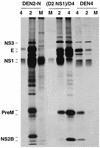Genetic determinants responsible for acquisition of dengue type 2 virus mouse neurovirulence
- PMID: 9445071
- PMCID: PMC124649
- DOI: 10.1128/JVI.72.2.1647-1651.1998
Genetic determinants responsible for acquisition of dengue type 2 virus mouse neurovirulence
Abstract
Studies conducted some 50 years ago showed that serial intracerebral passage of dengue viruses in mice selected for neurovirulent mutants that also exhibited significant attenuation for humans. We investigated the genetic basis of mouse neurovirulence of dengue virus because it might be directly or indirectly associated with attenuation for humans. Analysis of the sequence in the C-PreM-E-NS1 region of the parental dengue type 2 virus (DEN2) New Guinea C (NGC) strain and its mouse-adapted, neurovirulent mutant revealed that 10 nucleotide changes occurred during serial passage in mice. Seven of these changes resulted in amino acid substitutions, i.e., Leu55-Phe and Arg57-Lys in PreM, Glu71-Asp, Glu126-Lys, Phe402-Ile, and Thr454-Ile in E, and Arg105-Gln in NS1. The sequence of C was fully conserved between the parental and mutant DEN2. We constructed intertypic chimeric dengue viruses that contained the PreM-E genes or only the NS1 gene of neurovirulent DEN2 NGC substituting for the corresponding genes of DEN4. The DEN2 (PreM-E)/DEN4 chimera was neurovirulent for mice, whereas DEN2 (NS1)/DEN4 was not. The mutations present in the neurovirulent DEN2 PreM-E genes were then substituted singly or in combination into the sequence of the nonneurovirulent, parental DEN2. Intracerebral titration of the various mutant chimeras so produced identified two amino acid changes, namely, Glu71-Asp and Glu126-Lys, in DEN2 E as being responsible for mouse neurovirulence. The conservative amino acid change of Gu71-Asp probably had a minor effect, if any. The Glu126-Lys substitution in DEN2 E, representing a change from a negatively charged amino acid to a positively charged amino acid, most likely plays an important role in conferring mouse neurovirulence.
Figures



Similar articles
-
Construction of intertypic chimeric dengue viruses exhibiting type 3 antigenicity and neurovirulence for mice.J Virol. 1995 Aug;69(8):5186-90. doi: 10.1128/JVI.69.8.5186-5190.1995. J Virol. 1995. PMID: 7609092 Free PMC article.
-
Genetic determinants of dengue type 4 virus neurovirulence for mice.J Virol. 1993 Nov;67(11):6567-75. doi: 10.1128/JVI.67.11.6567-6575.1993. J Virol. 1993. PMID: 8411360 Free PMC article.
-
Mutational analysis of a neutralization epitope on the dengue type 2 virus (DEN2) envelope protein: monoclonal antibody resistant DEN2/DEN4 chimeras exhibit reduced mouse neurovirulence.Virology. 1996 Oct 15;224(2):437-45. doi: 10.1006/viro.1996.0550. Virology. 1996. PMID: 8874504
-
Chimeric tick-borne encephalitis and dengue type 4 viruses: effects of mutations on neurovirulence in mice.J Virol. 1993 Aug;67(8):4956-63. doi: 10.1128/JVI.67.8.4956-4963.1993. J Virol. 1993. PMID: 8331735 Free PMC article.
-
Chimeric flaviviruses: novel vaccines against dengue fever, tick-borne encephalitis, and Japanese encephalitis.Adv Virus Res. 2003;61:469-509. doi: 10.1016/s0065-3527(03)61013-4. Adv Virus Res. 2003. PMID: 14714441 Review.
Cited by
-
Yellow fever virus/dengue-2 virus and yellow fever virus/dengue-4 virus chimeras: biological characterization, immunogenicity, and protection against dengue encephalitis in the mouse model.J Virol. 2003 Mar;77(6):3655-68. doi: 10.1128/jvi.77.6.3655-3668.2003. J Virol. 2003. PMID: 12610141 Free PMC article.
-
Isolation and complete genome analysis of neurotropic dengue virus serotype 3 from the cerebrospinal fluid of an encephalitis patient.PLoS Negl Trop Dis. 2018 Jan 12;12(1):e0006198. doi: 10.1371/journal.pntd.0006198. eCollection 2018 Jan. PLoS Negl Trop Dis. 2018. PMID: 29329287 Free PMC article.
-
The C-terminal helical domain of dengue virus precursor membrane protein is involved in virus assembly and entry.Virology. 2011 Feb 5;410(1):170-80. doi: 10.1016/j.virol.2010.11.006. Epub 2010 Dec 3. Virology. 2011. PMID: 21129763 Free PMC article.
-
Attenuation of Murray Valley encephalitis virus by site-directed mutagenesis of the hinge and putative receptor-binding regions of the envelope protein.J Virol. 2001 Aug;75(16):7692-702. doi: 10.1128/JVI.75.16.7692-7702.2001. J Virol. 2001. PMID: 11462041 Free PMC article.
-
Perspectives for the treatment of infections with Flaviviridae.Clin Microbiol Rev. 2000 Jan;13(1):67-82, table of contents. doi: 10.1128/CMR.13.1.67. Clin Microbiol Rev. 2000. PMID: 10627492 Free PMC article. Review.
References
-
- Bray M, Lai C J. Dengue virus pre-membrane and membrane proteins elicit a protective immune response. Virology. 1991;185:505–508. - PubMed
-
- Bray M, Lai C J. Construction and characterization of chimeric dengue viruses. In: Brown F, Chanock R M, Ginsberg H S, Lerner R A, editors. Vaccine 92. Cold Spring Harbor, N.Y: Cold Spring Harbor Laboratory Press; 1992. pp. 271–276.
MeSH terms
LinkOut - more resources
Full Text Sources
Other Literature Sources

